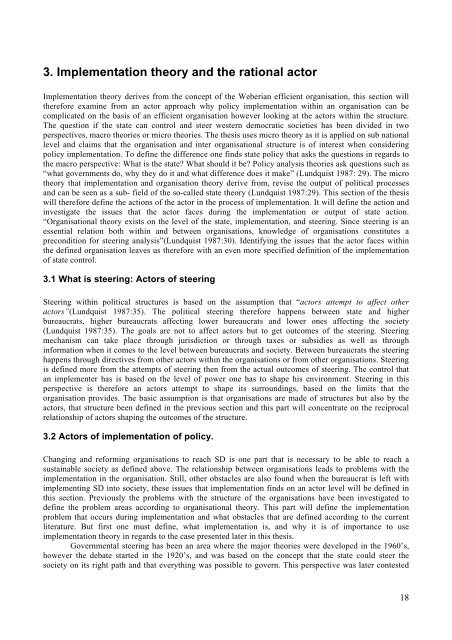From 'grey to green'- investigating the capabilities of the ... - lumes
From 'grey to green'- investigating the capabilities of the ... - lumes
From 'grey to green'- investigating the capabilities of the ... - lumes
Create successful ePaper yourself
Turn your PDF publications into a flip-book with our unique Google optimized e-Paper software.
3. Implementation <strong>the</strong>ory and <strong>the</strong> rational ac<strong>to</strong>rImplementation <strong>the</strong>ory derives from <strong>the</strong> concept <strong>of</strong> <strong>the</strong> Weberian efficient organisation, this section will<strong>the</strong>refore examine from an ac<strong>to</strong>r approach why policy implementation within an organisation can becomplicated on <strong>the</strong> basis <strong>of</strong> an efficient organisation however looking at <strong>the</strong> ac<strong>to</strong>rs within <strong>the</strong> structure.The question if <strong>the</strong> state can control and steer western democratic societies has been divided in twoperspectives, macro <strong>the</strong>ories or micro <strong>the</strong>ories. The <strong>the</strong>sis uses micro <strong>the</strong>ory as it is applied on sub nationallevel and claims that <strong>the</strong> organisation and inter organisational structure is <strong>of</strong> interest when consideringpolicy implementation. To define <strong>the</strong> difference one finds state policy that asks <strong>the</strong> questions in regards <strong>to</strong><strong>the</strong> macro perspective: What is <strong>the</strong> state? What should it be? Policy analysis <strong>the</strong>ories ask questions such as“what governments do, why <strong>the</strong>y do it and what difference does it make” (Lundquist 1987: 29). The micro<strong>the</strong>ory that implementation and organisation <strong>the</strong>ory derive from, revise <strong>the</strong> output <strong>of</strong> political processesand can be seen as a sub- field <strong>of</strong> <strong>the</strong> so-called state <strong>the</strong>ory (Lundquist 1987:29). This section <strong>of</strong> <strong>the</strong> <strong>the</strong>siswill <strong>the</strong>refore define <strong>the</strong> actions <strong>of</strong> <strong>the</strong> ac<strong>to</strong>r in <strong>the</strong> process <strong>of</strong> implementation. It will define <strong>the</strong> action andinvestigate <strong>the</strong> issues that <strong>the</strong> ac<strong>to</strong>r faces during <strong>the</strong> implementation or output <strong>of</strong> state action.“Organisational <strong>the</strong>ory exists on <strong>the</strong> level <strong>of</strong> <strong>the</strong> state, implementation, and steering. Since steering is anessential relation both within and between organisations, knowledge <strong>of</strong> organisations constitutes aprecondition for steering analysis”(Lundquist 1987:30). Identifying <strong>the</strong> issues that <strong>the</strong> ac<strong>to</strong>r faces within<strong>the</strong> defined organisation leaves us <strong>the</strong>refore with an even more specified definition <strong>of</strong> <strong>the</strong> implementation<strong>of</strong> state control.3.1 What is steering: Ac<strong>to</strong>rs <strong>of</strong> steeringSteering within political structures is based on <strong>the</strong> assumption that “ac<strong>to</strong>rs attempt <strong>to</strong> affect o<strong>the</strong>rac<strong>to</strong>rs”(Lundquist 1987:35). The political steering <strong>the</strong>refore happens between state and higherbureaucrats, higher bureaucrats affecting lower bureaucrats and lower ones affecting <strong>the</strong> society(Lundquist 1987:35). The goals are not <strong>to</strong> affect ac<strong>to</strong>rs but <strong>to</strong> get outcomes <strong>of</strong> <strong>the</strong> steering. Steeringmechanism can take place through jurisdiction or through taxes or subsidies as well as throughinformation when it comes <strong>to</strong> <strong>the</strong> level between bureaucrats and society. Between bureaucrats <strong>the</strong> steeringhappens through directives from o<strong>the</strong>r ac<strong>to</strong>rs within <strong>the</strong> organisations or from o<strong>the</strong>r organisations. Steeringis defined more from <strong>the</strong> attempts <strong>of</strong> steering <strong>the</strong>n from <strong>the</strong> actual outcomes <strong>of</strong> steering. The control thatan implementer has is based on <strong>the</strong> level <strong>of</strong> power one has <strong>to</strong> shape his environment. Steering in thisperspective is <strong>the</strong>refore an ac<strong>to</strong>rs attempt <strong>to</strong> shape its surroundings, based on <strong>the</strong> limits that <strong>the</strong>organisation provides. The basic assumption is that organisations are made <strong>of</strong> structures but also by <strong>the</strong>ac<strong>to</strong>rs, that structure been defined in <strong>the</strong> previous section and this part will concentrate on <strong>the</strong> reciprocalrelationship <strong>of</strong> ac<strong>to</strong>rs shaping <strong>the</strong> outcomes <strong>of</strong> <strong>the</strong> structure.3.2 Ac<strong>to</strong>rs <strong>of</strong> implementation <strong>of</strong> policy.Changing and reforming organisations <strong>to</strong> reach SD is one part that is necessary <strong>to</strong> be able <strong>to</strong> reach asustainable society as defined above. The relationship between organisations leads <strong>to</strong> problems with <strong>the</strong>implementation in <strong>the</strong> organisation. Still, o<strong>the</strong>r obstacles are also found when <strong>the</strong> bureaucrat is left withimplementing SD in<strong>to</strong> society, <strong>the</strong>se issues that implementation finds on an ac<strong>to</strong>r level will be defined inthis section. Previously <strong>the</strong> problems with <strong>the</strong> structure <strong>of</strong> <strong>the</strong> organisations have been investigated <strong>to</strong>define <strong>the</strong> problem areas according <strong>to</strong> organisational <strong>the</strong>ory. This part will define <strong>the</strong> implementationproblem that occurs during implementation and what obstacles that are defined according <strong>to</strong> <strong>the</strong> currentliterature. But first one must define, what implementation is, and why it is <strong>of</strong> importance <strong>to</strong> useimplementation <strong>the</strong>ory in regards <strong>to</strong> <strong>the</strong> case presented later in this <strong>the</strong>sis.Governmental steering has been an area where <strong>the</strong> major <strong>the</strong>ories were developed in <strong>the</strong> 1960’s,however <strong>the</strong> debate started in <strong>the</strong> 1920’s, and was based on <strong>the</strong> concept that <strong>the</strong> state could steer <strong>the</strong>society on its right path and that everything was possible <strong>to</strong> govern. This perspective was later contested18
















